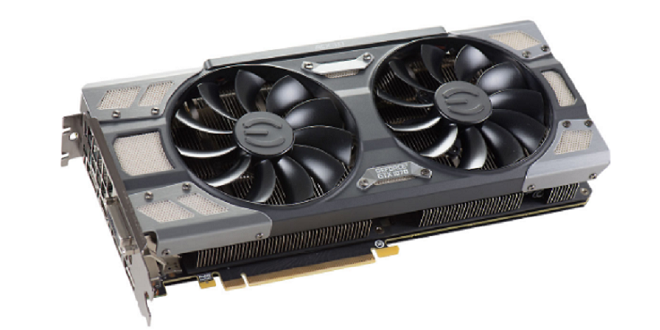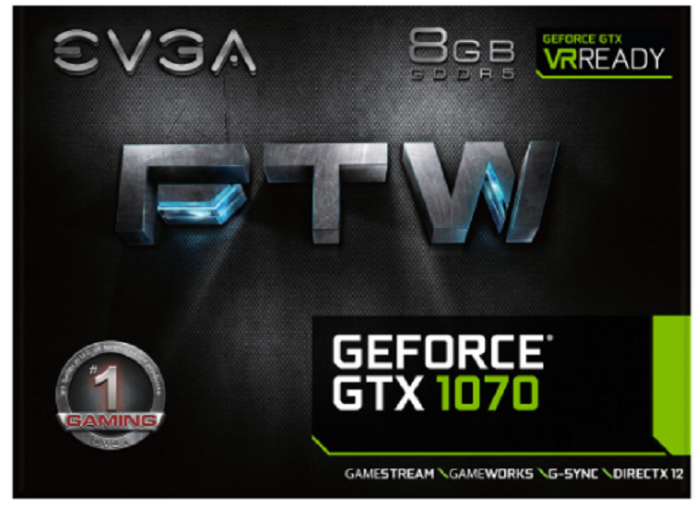EVGA GeForce GTX 1070 FTW GAMING ACX 3.0
Once again, EVGA has graced us by sending the EVGA GeForce GTX 1070 FTW GAMING ACX 3.0. This time it’s the EVGA GeForce GTX 1070 FTW GAMING ACX 3.0 with it’s Pascal GPU. The Pascal GPU is NVIDIA’s most advanced GPU core ever produced and utilizes a 16nm FinFET process from the Taiwan Semiconductor Manufacturing Company. TMSC uses a third generation High-k/Metal Gate process, and a fifth generation transistor strain process with a 193nm lithography. As a result of the 16nm process used in Pascal GPUs, you can achieve the same or greater GPU capabilities with less power. TSMC’s 16FF technology can provide up to 65% greater speeds at around 2 times the density or 70% less power usage than its 28HPM technology.
Now combine TSMC’s 16FF technology with NVIDIA’s Pascal GPU and let EVGA put their unique spin to it, and you have one heck of a mind-blowing EVGA GeForce GTX 1070 FTW GAMING ACX 3.0. The core clock runs at 1607MHz, with a 1797MHz boost clock, and is powered by two 8-pin connector. The card also features dual BIOS chips, 10 + 2 phase power and a 215 watt TDP.
Now that’s not all the goodies packed into this son of a beast, that’s just the core specs and some details about the FinFET process. EVGA throws on more than double the phase power of a reference design which on most models is 4 + 1 phase power. We especially like the dual BIOS; no bricking on flash upgrades. Flash a BIOS and get a failure? Just switch to the backup BIOS and re-flash the bad BIOS and you’re running non-stop.
We’ll get into in-depth shortly, but you are going to love the RGB colors and the ACX 3.0 cooling. You’ll be hard pressed to find a GTX 1070 better equipped than the .
Highlighted Features & Specifications
- 1797 MHz boost clock for outstanding performance and gaming experience.
- ACX 3.0 Double Ball Bearing Fans 400% Lifespan Compared to normal bearing fans.
- MMCP Memory Mosfet Cooling Plate 15% cooler Memory, 13% cooler Mosfets.
- Adjustable RGB LEDS to Coordinate System Colors.
- DVI-D x 1, HDMI x 1, Display Port X 3 for maximum connectivity.
- Precision XOC built for Pascal GPU’s Use those 10 + 2 Phase Power Circuits.
- NVIDIA ANSEL for a revolutionary new way to capture in-game screenshots.
- NVIDIA GameWorks™ provides an interactive and cinematic experience, as well as incredibly smooth gameplay.
GPU Comparison Table
| GPU | EVGA GeForce GTX 1070 FTW Gaming ACX 3.0 | NVIDIA GeForce GTX 1080 8GB |
NVIDIA GeForce GTX Titan X 12GB |
NVIDIA GeForce GTX 980 Ti 6GB |
NVIDIA GeForce GTX 980 4GB |
| Architecture | Pascal | Pascal | Maxwell | Maxwell | Maxwell |
| Codename | GP104-200-A1 | GP104 | GM200 | GM200 | GM204 |
| Base Clock |
1607MHz | 1,607MHz | 1,000MHz | 1,000MHz | 1,126MHz |
| Boost Clock |
1797MHz | 1,733MHz | 1,075MHz | 1,075MHz | 1,216MHz |
| Stream Processors |
1920 | 2,560 | 3,072 | 2,816 | 2,048 |
| Layout | 3 GPCs, 15 SMs | 4 GPCs, 20 SMs | 6 GPCs, 24 SMMs | 6 GPCs, 22 SMMs | 4 GPCs, 16 SMMs |
| Rasterisers | 3 | 4 | 6 | 6 | 4 |
| Tesselation Units |
15 | 20 | 24 | 22 | 16 |
| Texture Units |
120 | 160 | 192 | 176 | 128 |
| ROPs | 64 | 64 | 96 | 96 | 64 |
| FP64 Performance |
1/32 FP32 | 1/32 FP32 | 1/32 FP32 | 1/32 FP32 | 1/32 FP32 |
| Transistors | 7.2 Billion |
7.2 billion |
8 billion |
8 billion |
5.2 billion |
| Die Size |
314mm2 | 314mm2 | 601mm2 | 601mm2 | 398mm2 |
| Process | 16nm | 16nm | 28nm | 28nm | 28nm |
| Memory | |||||
| Amount | 8GB GDDR5 |
8GB GDDR5X |
12GB GDDR5 |
6GB GDDR5 |
4GB GDDR5 |
| Frequency | 1GHz (8GHz effective) |
1.25GHz (10GHz effective) |
1.75GHz (7GHz effective) |
1.75GHz (7GHz effective) |
1.75GHz (7GHz effective) |
| Interface | 256-bit | 256-bit | 384-bit | 384-bit | 256-bit |
| Bandwidth | 256GB/sec | 320GB/sec | 336GB/sec | 336GB/sec | 224GB/sec |
| Card Specifications | |||||
| Power Connectors |
2 x 8-pin | 1 x 8-pin | 1 x 6-pin, 1 x 8-pin | 1 x 6-pin, 1 x 8-pin | 2 x 6-pin |
| Stock Card Length |
267mm | 267mm | 267mm | 267mm | 267mm |
| TDP | 215W | 180W | 250W | 250W | 165W |
Key Features
- Simultaneous Multi-Projection
- VR Ready
- NVIDIA Ansel
- NVIDIA SLI w/ HB Bridge Support
- NVIDIA G-SYNC
- NVIDIA GameStream
- NVIDIA GPU Boost 3.0
- Microsoft DirectX 12
- Vulkan API
- OpenGL 4.5 Support
- PCI Express 3.0
- Max Digital Resolution – 7680×4320
- HDMI 2.0b, DisplayPort 1.4 and Dual-Link DVI
- Built for EVGA Precision XOC
 Bjorn3D.com Bjorn3d.com – Satisfying Your Daily Tech Cravings Since 1996
Bjorn3D.com Bjorn3d.com – Satisfying Your Daily Tech Cravings Since 1996








2160P(4K) is not a gaming resolution due to current displays being limited to only 60hz atm. The GTX 1070 and even 1080 really excel at 1440P and are stunningly mediocre at 2160P. I feel reviewers should be leading reader to the performance vs visuals sweet spot that is 1440P. I find the “Final thoughts” 4k statement a tad misleading for the less informed reader that could contribute some readers making the mistake of going 4K. There is no doubt 4K is coming probably the next GPU architecture in combination of display port 1.3 and above, but we are not there yet its simply not a great option!.
Beyond that a good review.
Right, because gaming definitely didn’t exist before the invention of high refresh rate LCDs a few years ago.
You tried, man. CRT monitors were equal to or better than the response times and refresh rates of the displays we have now. They just consumed a lot more space and power. 🙂